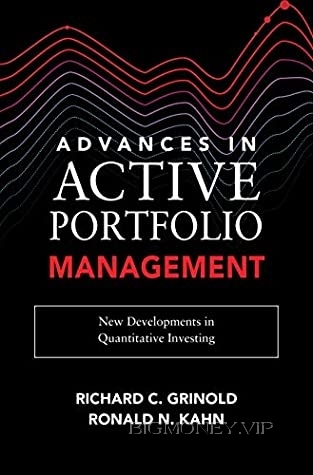Advances in Active Portfolio Management: New Developments in Quantitative Investing by Ronald N. Kahn

1
Introduction: Advances in Active
Portfolio Management
The quantitative approach to active management has developed over the
past 65 years. In 1952, Markowitz framed investing as a trade-off between
expected return and risk—which he defined as the variance of return—
opening portfolio management to quantitative analysis.1
Subsequent
developments like the capital asset pricing model and the efficient markets
hypothesis quickly focused academics on indexing: passive investing. But,
starting in the 1970s, a number of separate efforts created a quantitative
framework for active investing.
In 1995, and with a second edition in 2000, our book, Active Portfolio
Management, brought all these threads together into a coherent theory of
active management. We described how to develop forecasts of risk, return,
and cost and how to combine those elements into active portfolios. We
presented the information ratio—the ratio of active return to active risk—as
the key statistic for active management. All investors seek active managers
with high information ratios. The fundamental law of active management
(Grinold 1989), a central concept of the book, shows that high information
ratios require some winning combination of skill in making investment
decisions; breadth of those decisions, for diversification; and efficiency of
implementation, so that the portfolio accurately captures the manager’s
views. The book was very popular when first published, and remains
popular to this day, because it is the recognized authority on quantitative
active management.
We have not stood still since 2000. The theory and framework of Active
Portfolio Management were state-of-the-art when written, but we have
advanced the state of the art since then, in particular in viewing active
management as a dynamic problem rather than a one-period challenge, and
also in advancing portfolio analysis to provide new perspectives.
The world of active management has also not stood still since 2000.
Issues, trends, and challenges have appeared since the publication of Active
Portfolio Management, and we have published many articles on these
emerging trends in refereed journals. Those articles applied the Active
Portfolio Management framework to analyze new problems.
This book, Advances in Active Portfolio Management, is a companion
and successor book to Active Portfolio Management. Articles and essays we
have written—together and separately, mainly since the publication of
Active Portfolio Management—compose the chapters in this book. We have
chosen articles mainly along three dimensions: a recap of Active Portfolio
Management, advancing the Active Portfolio Management framework, and
applying the Active Portfolio Management framework to newer problems.
We have used those three dimensions to organize the book. For each article
or group of related articles, we have added an introduction reviewing the
material with the benefit of time and providing context and background
useful for reading the articles.
Section 1 recaps Active Portfolio Management. After the introduction to
this section comes the chapter “Seven Insights into Active Management,” a
summary of seven key themes in that original book. “A Retrospective Look
at the Fundamental Law of Active Management” reviews how this key idea
has impacted the field in the 30 years since its publication. “Breadth, Skill,
and Time” then provides significant additional insight and detail into the
concept of breadth, the least understood component of the fundamental law.
Section 2 covers advances in active portfolio management. The chapters
in this section fall into two general categories: dynamic portfolio
management (Section 2.1) and portfolio analysis and attribution (Section
2.2). The introduction to Section 2.1 provides an important overview to a
set of articles describing theory that developed over time. This dynamic
portfolio management section includes five articles: “Implementation
Efficiency,” “Dynamic Portfolio Analysis,” “Signal Weighting,” “Linear
Trading Rules for Portfolio Management,” and “Nonlinear Trading Rules
for Portfolio Management.” The “Dynamic Portfolio Analysis” paper won




